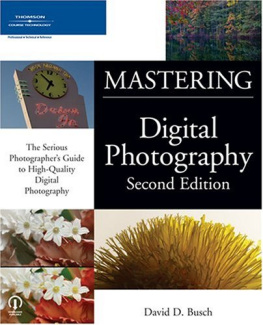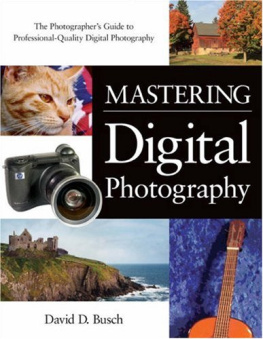Andy Rowlands - Physics of Digital Photography
Here you can read online Andy Rowlands - Physics of Digital Photography full text of the book (entire story) in english for free. Download pdf and epub, get meaning, cover and reviews about this ebook. City: Blue Ridge Summit;Philadelphia, year: 2017, publisher: IOP Publishing;Institute of Physics Publishing, National Book Network [distributor, genre: Children. Description of the work, (preface) as well as reviews are available. Best literature library LitArk.com created for fans of good reading and offers a wide selection of genres:
Romance novel
Science fiction
Adventure
Detective
Science
History
Home and family
Prose
Art
Politics
Computer
Non-fiction
Religion
Business
Children
Humor
Choose a favorite category and find really read worthwhile books. Enjoy immersion in the world of imagination, feel the emotions of the characters or learn something new for yourself, make an fascinating discovery.
- Book:Physics of Digital Photography
- Author:
- Publisher:IOP Publishing;Institute of Physics Publishing, National Book Network [distributor
- Genre:
- Year:2017
- City:Blue Ridge Summit;Philadelphia
- Rating:4 / 5
- Favourites:Add to favourites
- Your mark:
- 80
- 1
- 2
- 3
- 4
- 5
Physics of Digital Photography: summary, description and annotation
We offer to read an annotation, description, summary or preface (depends on what the author of the book "Physics of Digital Photography" wrote himself). If you haven't found the necessary information about the book — write in the comments, we will try to find it.
Physics of Digital Photography — read online for free the complete book (whole text) full work
Below is the text of the book, divided by pages. System saving the place of the last page read, allows you to conveniently read the book "Physics of Digital Photography" online for free, without having to search again every time where you left off. Put a bookmark, and you can go to the page where you finished reading at any time.
Font size:
Interval:
Bookmark:

IOP Series: Emerging Technologies in Optics and Photonics
Series Editor

R Barry Johnson a Senior Research Professor at Alabama A&M University, has been involved for over 40 years in lens design, optical systems design, electro-optical systems engineering, and photonics. He has been a faculty member at three academic institutions engaged in optics education and research, employed by a number of companies, and provided consulting services.
Dr Johnson is an SPIE Fellow and Life Member, OSA Fellow, and was the 1987 President of SPIE. He serves on the editorial board of Infrared Physics & Technology and Advances in Optical Technologies. Dr Johnson has been awarded many patents, has published numerous papers and several books and book chapters, and was awarded the 2012 OSA/SPIE Joseph W Goodman Book Writing Award for Lens Design Fundamentals, Second Edition. He is a perennial co-chair of the annual SPIE Current Developments in Lens Design and Optical Engineering Conference.
Foreword
Until the 1960s, the field of optics was primarily concentrated in the classical areas of photography, cameras, binoculars, telescopes, spectrometers, colorimeters, radiometers, etc. In the late 1960s, optics began to blossom with the advent of new types of infrared detectors, liquid crystal displays (LCD), light emitting diodes (LED), charge coupled devices (CCD), lasers, holography, fiber optics, new optical materials, advances in optical and mechanical fabrication, new optical design programs, and many more technologies. With the development of the LED, LCD, CCD and other electo-optical devices, the term photonics came into vogue in the 1980s to describe the science of using light in development of new technologies and the performance of a myriad of applications. Today, optics and photonics are truly pervasive throughout society and new technologies are continuing to emerge. The objective of this series is to provide students, researchers, and those who enjoy self-teaching with a wide-ranging collection of books that each focus on a relevant topic in technologies and application of optics and photonics. These books will provide knowledge to prepare the reader to be better able to participate in these exciting areas now and in the future. The title of this series is Emerging Technologies in Optics and Photonics where emerging is taken to mean coming into existence, coming into maturity, and coming into prominence. IOP Publishing and I hope that you find this Series of significant value to you and your career.
Andy Rowlands
IOP Publishing, Bristol, UK
IOP Publishing Ltd 2017
All rights reserved. No part of this publication may be reproduced, stored in a retrieval system or transmitted in any form or by any means, electronic, mechanical, photocopying, recording or otherwise, without the prior permission of the publisher, or as expressly permitted by law or under terms agreed with the appropriate rights organization. Multiple copying is permitted in accordance with the terms of licences issued by the Copyright Licensing Agency, the Copyright Clearance Centre and other reproduction rights organisations.
Permission to make use of IOP Publishing content other than as set out above may be sought at permissions@iop.org.
Andy Rowlands has asserted his right to be identified as the author of this work in accordance with sections 77 and 78 of the Copyright, Designs and Patents Act 1988.
ISBN 978-0-7503-1242-4 (ebook)
ISBN 978-0-7503-1243-1 (print)
ISBN 978-0-7503-1244-8 (mobi)
DOI 10.1088/978-0-7503-1242-4
Version: 20170401
IOP Expanding Physics
ISSN 2053-2563 (online)
ISSN 2054-7315 (print)
British Library Cataloguing-in-Publication Data: A catalogue record for this book is available from the British Library.
Published by IOP Publishing, wholly owned by The Institute of Physics, London
IOP Publishing, Temple Circus, Temple Way, Bristol, BS1 6HG, UK
US Office: IOP Publishing, Inc., 190 North Independence Mall West, Suite 601, Philadelphia, PA 19106, USA
For my parents, Ann and Gareth.
My aim in writing this book is to provide a theoretical overview of the photographic imaging chain. The book is intended for use by graduate students and researchers entering imaging science, and for photographers with a graduate level technical background. For existing researchers, it should serve as a link between imaging science and photographic practice.
Chapter continues the imaging chain by providing an introduction to digital output, before going on to discuss exposure strategy in digital photography. The aim is to produce a digital output image file with specified characteristics such as a standard brightness.
Chapter .
Chapter describes the physical principles behind some of the main steps involved in converting the raw data into a viewable output image. A large part of the chapter is devoted to colour theory and the implementation of white balance in digital cameras.
Chapter explains the theory required for interpreting image quality metrics used by reviewers of digital cameras and lenses. Theory for cross-format comparisons is described in detail. Practical strategies for maximising the full image quality potential of a camera system are also discussed.
Data obtained from the Olympus E-M1 camera has been used to illustrate various examples in this book.
Certain topics have been omitted which I believe are already well-covered elsewhere. In particular, I have chosen to concentrate on the physics of digital photography itself rather than the underlying camera technology. The book Camera Technology: the Dark Side of the Lens by N Goldberg is an excellent resource on this topic. Although it is written about film cameras, many of the concepts carry over to digital cameras. Furthermore, many excellent books have been written about sensor technology and signal processing, and I highly recommend Image Sensors and Signal Processing for Digital Still Cameras edited by J Nakamura.
I would like to thank Professor R Barry Johnson and Dr Rafal Mantiuk for helpful discussions and suggestions. Dave Coffin provided some useful information about his dcraw raw converter, and the late Dr Hubert Nasse kindly gave permission to reproduce several figures from his articles. Finally, I would like to thank the production staff at IOP Publishing, and in particular Dr John Navas, for overseeing the commissioning and publication of this book.
Andy Rowlands, January 2017
Derwyn Andrew Rowlands

Andy Rowlands gained a first class joint honours degree in Mathematics and Physics in 2000, and received his PhD in Physics in 2004 from the University of Warwick, UK. For his PhD he developed a method for treating short-range order in the first-principles quantum description of substitutionally disordered metallic systems.
He was subsequently awarded a Fellowship in Theoretical Physics from the Engineering and Physical Sciences Research Council (EPSRC) which he held at the University of Bristol, UK, from 2004 to 2007. This was followed by a further postdoctoral position at Lawrence Livermore National Laboratory (LLNL) in California, USA, in 2008.
Font size:
Interval:
Bookmark:
Similar books «Physics of Digital Photography»
Look at similar books to Physics of Digital Photography. We have selected literature similar in name and meaning in the hope of providing readers with more options to find new, interesting, not yet read works.
Discussion, reviews of the book Physics of Digital Photography and just readers' own opinions. Leave your comments, write what you think about the work, its meaning or the main characters. Specify what exactly you liked and what you didn't like, and why you think so.



